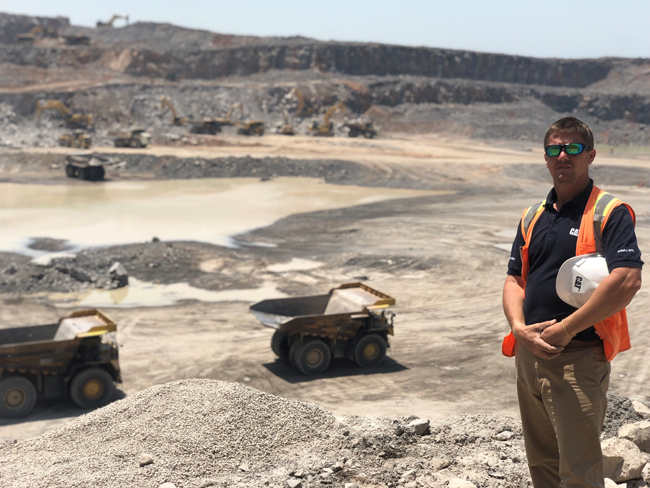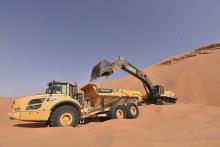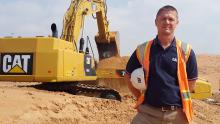
The Middle East aggregates sector has seen healthy growth over the last year, driven by government spending to extract more oil and gas, and by a number of massive infrastructure projects. Liam McLoughlin reports.
The aggregates sector in the Middle East has expanded over the last year, chiefly driven by increased spending by governments in the region on projects to extract more oil and gas.
Despite the ongoing Qatar political and trade dispute, the aggregates sector in the Gulf region (which covers Bahrain, Iran, Iraq, Kuwait, Oman, Qatar, Saudi Arabia and the United Arab Emirates) increased by around 10% in 2018 and the first part of 2019 compared to 2016 and 2017, according to Gary Martin of quarrying equipment manufacturer
“In the Kingdom of Saudi Arabia (KSA) nearly all the larger projects in the eastern region are related to the oil and gas segment,” says Martin, who is heavy construction & quarry application senior specialist for Africa and the Middle East at Caterpillar. “With these projects we are seeing some trends in face loading and hauling equipment acquisitions as the fuel price is pushing customers to look for the lowest cost per tonne.”
He adds that it is a promising time for both local and export markets in the Gulf states, particularly in terms of infrastructure projects that are starting to come online.
This view is supported by Shahir El Essawy, project director for Africa and the Middle East within
One of these projects is the recently awarded artificial islands construction scheme in Abu Dhabi to increase gas production. In February this year Abu Dhabi National Oil Company (ADNOC) announced the award of a dredging, land reclamation and marine construction contract to build artificial islands in the first phase of development of the Ghasha Concession.
The project is expected to take 38 months to complete and will provide the infrastructure required to further develop, drill and produce gas from the sour gas fields in the Ghasha Concession. Martin says that the project is estimated to require 20,000,000 tonnes of material to construct the 13 islands, with 60% of the rock being core aggregates and 40% being the larger armour rock from one to nine tonne per rock.
Martin says that schemes such as Ghasha are having an impact on quarries within the UAE, with production increasing by more than 30% on normal to be able to supply such projects. He added that this was a “very welcoming sign” in the wake of the negative impact on export of aggregates to Qatar that resulted from the recent political and trade dispute. In June 2017 Saudi Arabia, the UAE, Bahrain and Egypt imposed a trade and travel ban on Qatar, alleging it supported terrorist groups (a charge which Qatar denies).
According to Martin, the negative impact of the Qatar export ban on the UAE has become a positive for Oman, where aggregate sales increased as Qatar sought another region to supply its much-needed tonnage. “We have seen an increase in machine sales in the Oman quarrying industry and we are enjoying this much-needed boost to the country,” he adds.
The NEOM megacity project in the Tabuk region of the KSA, to start within the second half of 2019 “will kickstart the quarry and aggregates business again for the Kingdom”, Martin predicts.
He says a preference for loading at the face has seen its Oman and UAE customers opting for the Cat 374F L excavator due to its productivity and fuel efficiency. He adds that, for hauling, customers in Oman and the UAE keep to the 40 tonne Cat 770G truck.
“The choice of the 770G is not only down to fuel efficiency, but for customers that have run 769D and 771D trucks in the past they have built their quarries around the 40 tonne size class, so the 770G is the ideal replacement for an older fleet,” says Martin.
He adds that in the KSA the preference for face loading is moving from large excavators, as seen in the Gulf, to large wheeled loaders such as the Cat 988K and 992K which are matched with the 775F/G and 777F/G quarry trucks.
“In the KSA there is not as much pressure on cost per tonne, although these models hit the criteria for efficiency and a low cost per tonne,” he says. “I think the reason for larger trucks is more from the higher tonnage requirements needed per hour and the longer hauling distances from the face to the crusher.”
Taking a broader market view across the whole Middle East quarrying sector, El Essaway says there is an increased focus among customers on total cost of ownership and boosting efficiency.
“The biggest demand in the Middle East is for our wheeled loaders, excavators, articulated haulers and rigid haulers,” he adds.
One of the biggest infrastructure projects currently taking place in the Middle East is the construction of Egypt’s new capital city 45 kilometres outside of Cairo. The city – which has not yet been named and is referred to as the new administrative capital (NAC) – will become the country’s administrative and financial centre with around five million inhabitants.
Such projects are driving demand for more raw material and therefore more business for the quarrying/aggregates segment, according to El Essawy of Volvo CE.
Since the start of construction work on the new Egyptian capital, building materials giant LafargeHolcim has supported several of its projects. These include the Iconic Tower, which is set to become the highest tower in Africa with a height of 385m when completed by the end of 2020.
Miljan Gutovic,
LafargeHolcim is providing a range of specialty solutions for several landmark buildings in the new capital. For the Iconic Tower, the company is using a sustainable cement solution with higher slag contents to meet the contractor’s specifications. The solution is unique to the Egyptian market and it provides an extended lifetime of more than 100 years due to its higher durability and strength, which are essential for a structure of this size and weight. LafargeHolcim was the exclusive cement supplier for the tower’s base construction work, and in February this year poured concrete nonstop for 48 hours, which the company says is the country’s longest-ever concrete pour. It adds that its production and logistics capabilities meant it could supply large quantities of cement in a short time, significantly cutting the time needed for the pour.
LafargeHolcim is also providing lightweight concrete solutions for the Egyptian Cabinet building, which will be part of the government district of the new city and will include the parliament, ministries and other state institutions. These lightweight solutions are designed to deliver adequate strength and density values and minimise dead loads on the building. Additionally, the company is supplying further solutions for several other ministry buildings.
To ensure materials are delivered reliably and on time, a new concrete batching plant has been installed on-site. Another one with an expected production capacity of 300,000m3 was scheduled to open by the end of Q1. LafargeHolcim says its state-of-the-art local laboratory means it can test both its own solutions as well as construction materials provided by other suppliers.
The project for the new capital, which will also feature an airport and a theme park four times the size of Disneyland in California, was first announced in March 2015. The Egyptian government has said a new capital is needed to relieve congestion in Cairo, which has been the national capital since 969AD and whose 22 million population is predicted to double over the next few decades. The first officials are scheduled to move into government buildings in the new capital this year.
LafargeHolcim says it is engaged in several other major projects in Egypt that support the country’s growth agenda, including two new metro lines in Cairo, the new Suez Canal tunnels and several port extensions.
Northern Irish bulk materials handling company
Port of Salalah is a major trans-shipment hub positioned among the world’s top ports and is central to the economic future of Oman. Strategically located at the major East-West Shipping Lane, it is viewed as the region’s best-located port in order to access the Middle East, Indian subcontinent and East Africa. The port (in which APM Terminals holds a minority stake) is currently undergoing an expansion which will double the quay length and increase dry bulk capacity to 20 million tonnes annually.
Port of Salalah is made up of a container terminal with seven berths of up to 18m draft and a general cargo terminal of twelve berths of up to 16m draft, with infrastructure to handle the world’s largest container vessels, as well as bulk cargo, bunkering and warehousing.
As part of this expansion, Port of Salalah has appointed Telestack in a £4.8m deal to provide this unique shiploading system to handle the added capacity generated by the infrastructure investment and cater for the export requirements of the local mining, quarrying and cement industries.
According to Telestack’s commercial director, Malachy Gribben: “The Port of Salalah project is our largest single order ever and is the first system of its kind across the globe. Prior to the Telestack system, Maersk had been loading with grabs and mobile harbour cranes. This process was inefficient, time-consuming and costly, and it also resulted in the double handling of materials.”
The commissioning includes two shiploading systems, with each suite comprising a TB60 All Wheel Travel Shiploader fed by a Titan dual-feed All Wheel Travel 800-6 Bulk Reception Feeder. The equipment is designed to load limestone, gypsum and cement clinker at average rates up to 1,200tph to Handymax and Panamax/post-Panamax vessels.
The material that will be handled is free flowing, dusty and abrasive so Telestack says it was vital that its engineers ensured that the equipment would be long-lasting and fully functional throughout the project. The Export TB60 All Wheel Travel Shiploader has a 60m boom length enabling it to load up to post-Panamax size. The maximum freeboard height achievable is up to 15m. A central factor in the design was the ability to maximise hatch coverage and trimming ability as a result of having an independent radial telescopic shiploader with a separate dual feed truck unloading system.
Dust containment and suppression options were taken into significant consideration during the design stage of the shiploading system, and both the Titan 800-6 Dual Feed AWT TU and TB60 AWT were customised with galvanised dust covers the entire length of the incline conveyor and side wind plates on the inner conveyor. The two units also have integrated dust extraction filters fitted above the unloading point including an air compressor and dust filter.
The TB60 was designed with canvas retractable telescopic dust covers on the inner conveyor as well as a fully enclosed hood at the transfer point from outer to inner. All these additional features are designed to help ensure that the application is as environmentally friendly as possible and the entire shiploading process is now virtually dust free.
Degradation and contamination of material could compromise the composition and size of the product and could, in effect, reduce the selling price per tonne. Telestack says the implementation of its system means that double handling of materials is eliminated. This, coupled with the high abrasiveness of gypsum, limestone and clinker, makes it a very demanding application and Telestack says this is why its engineers incorporated transfer points, feed-boots and ceramic lining to ensure that the unit was hard-wearing.
The company adds that its shiploading system offers “unrivalled flexibility” in a range of applications (stockpiling, bay loading, linking, shiploading and reclaiming). It says that the mobility options of the units allow for the operator to utilise this technology anywhere on site ensuring a high-production capacity.
The All Wheel travel technology is designed to reduce hatch change times, particularly when loading geared vessels or vessels with vertical hatches as the shiploader boom only needs to be retracted before moving in parallel to the next hatch, thus reducing loading times, maximising production rates and minimising labour on site.
To further the success of this shiploading system, Telestack secured a tender from South African company Transnet to design, manufacture and install the same equipment.









